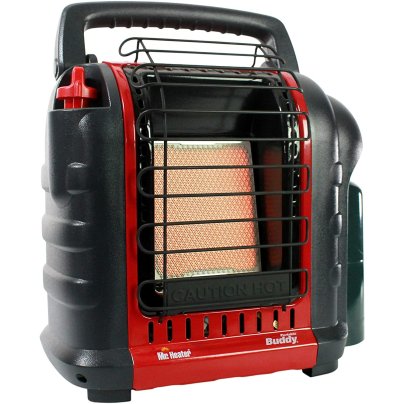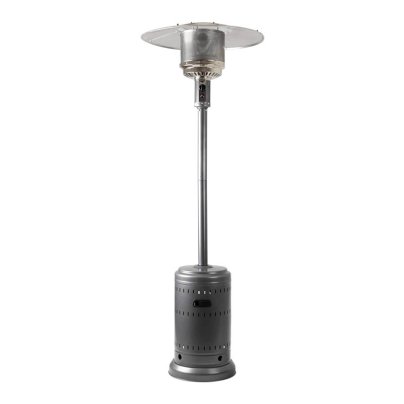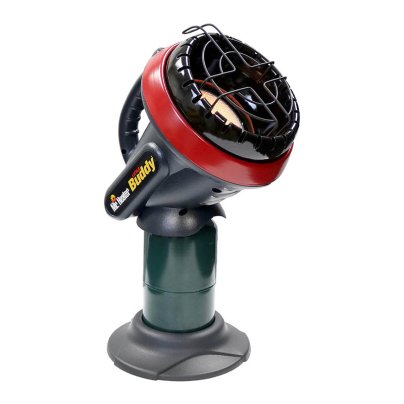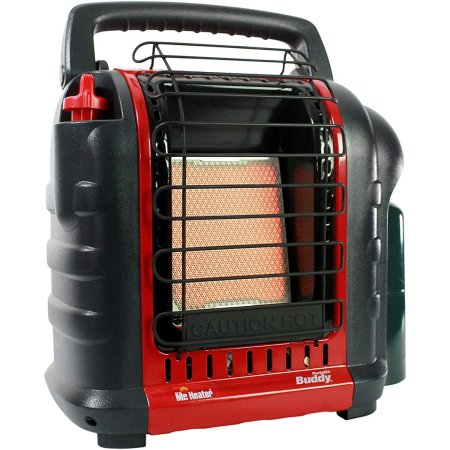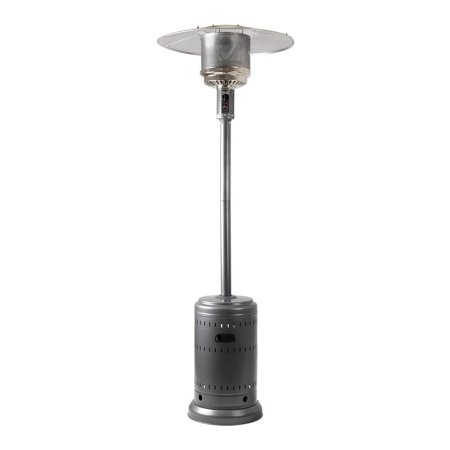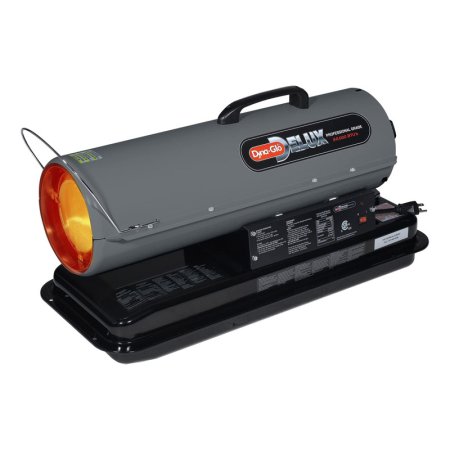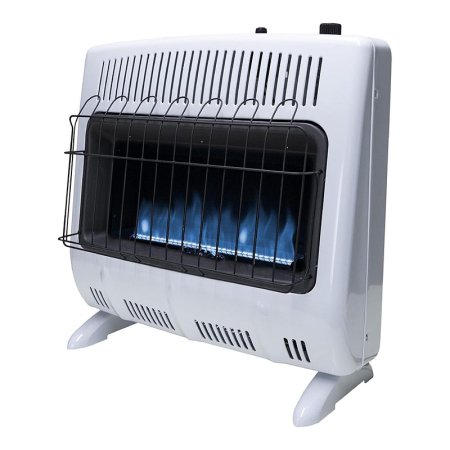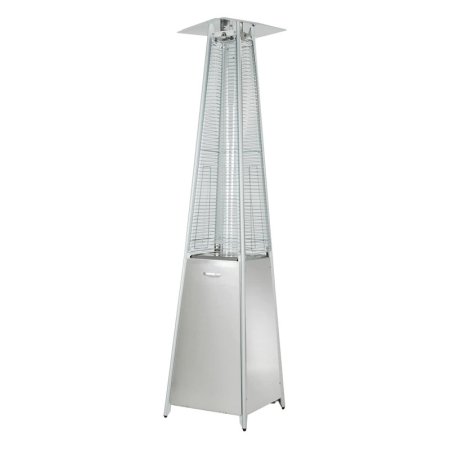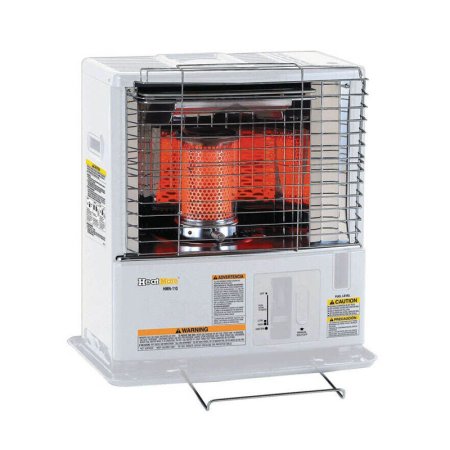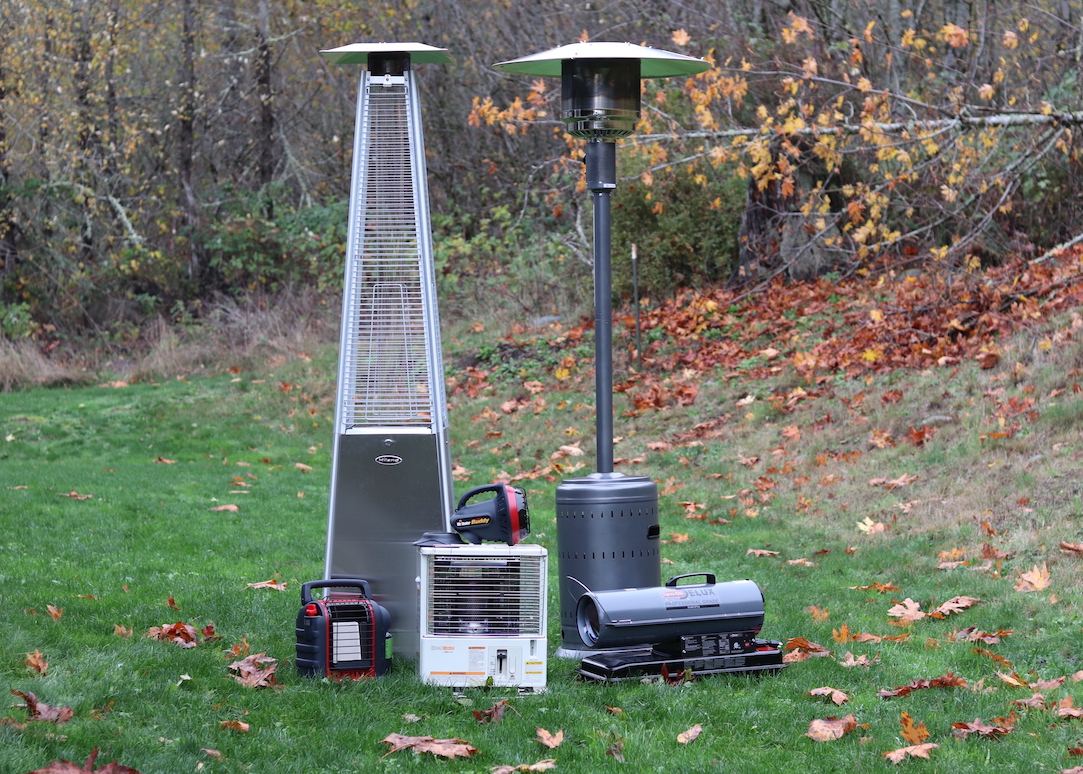
We may earn revenue from the products available on this page and participate in affiliate programs. Learn More ›
A midwinter ice storm has knocked out the power on your block, and the temperature on the thermostat is plummeting. With the power company sidelined by impassable roads, you are left to fend for yourself. Are you prepared? If not, get prepared by investing in a reliable non-electric heater to keep your family toasty when your HVAC system can’t.
Finding the perfect non-electric heater includes evaluating the types, figuring out the spaces it needs to heat, and determining how portable the unit needs to be. Keep reading to learn about these and other important shopping considerations, and check out some of the best non-electric heaters below. Each of these can help keep you all warm and fuzzy whether you have electricity or not. We did hands-on testing with most of these heaters (there was only one that we didn’t try ourselves) to learn their ins and outs, and we did the assembly ourselves, too. That gave us a better picture of how, when, and where these heaters function best.
- BEST OVERALL: Mr. Heater MH9BX Portable Buddy Propane Heater
- BEST BANG FOR THE BUCK: Amazon Basics 46,000 BTU Outdoor Propane Patio Heater
- BEST COMPACT: Mr. Heater MH4B Little Buddy Propane Heater
- BEST KEROSENE: Dyna-Glo 50,000 BTU Kerosene Forced-Air Heater
- BEST NATURAL GAS: Mr. Heater Vent-Free Blue Flame Natural Gas Heater
- BEST PROPANE: Dura Heat TT-360 Propane 360-Degree Tank Top Heater
- BEST FOR OUTDOORS: AZ Patio Heaters Hiland Portable Propane Patio Heater
- ALSO CONSIDER: Sengoku HeatMate Kerosene Radiant Heater
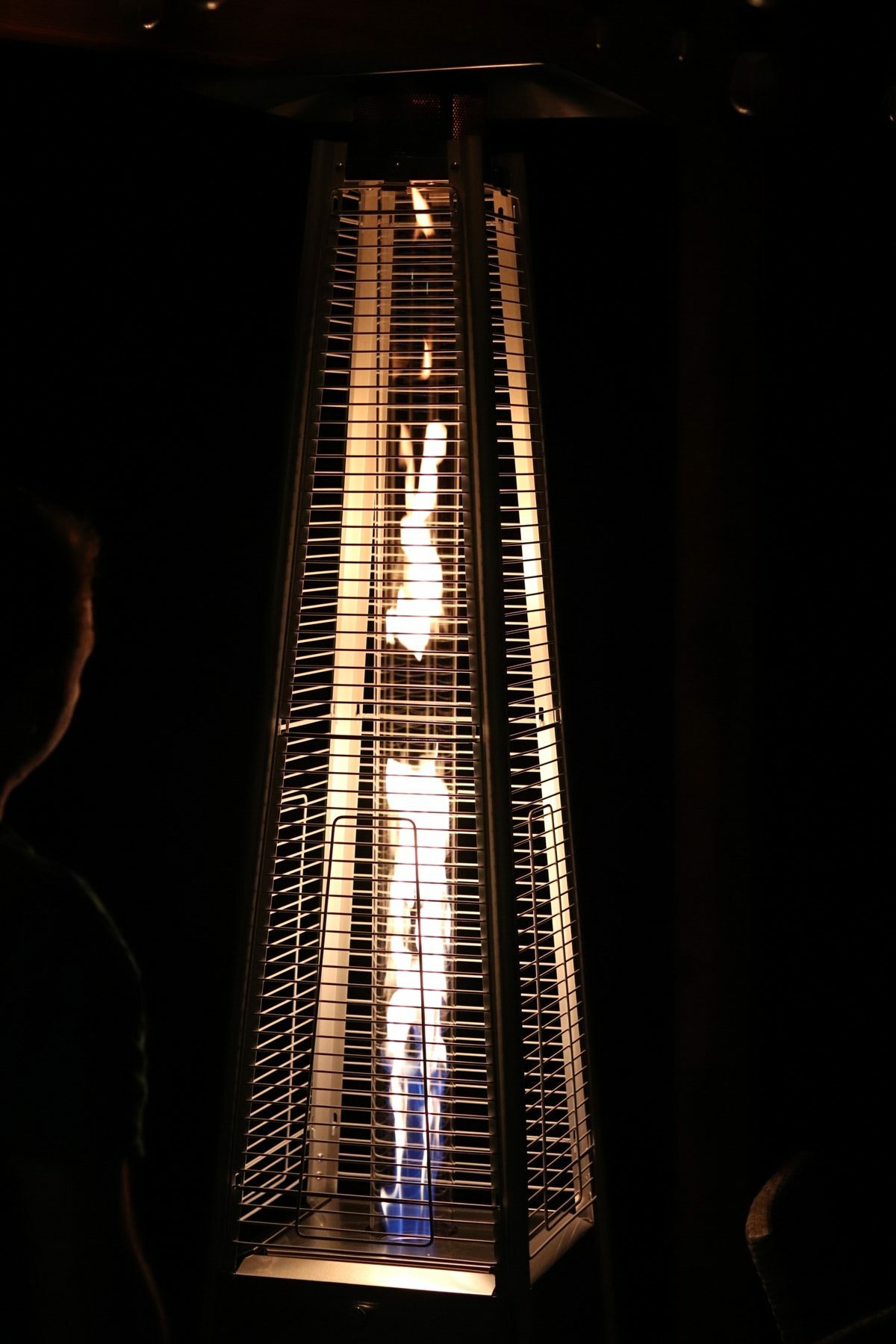
Before You Buy a Non-Electric Heater
Before shopping for a non-electric heater, it’s important to understand the product’s limitations. A non-electric heater shouldn’t replace a home’s primary HVAC system. Attempting to use a non-electric heater as the main source of heat for a home presents several hazards. Gas heaters can produce high carbon monoxide levels in a home, which can cause illness and even death if not carefully monitored. Non-electric heaters also use an open flame and fuel, creating a potential fire hazard.
For these reasons, non-electric heaters should never be left unattended for long and should never be used in a confined space with sealed doors and windows. It’s also a good idea to have a separate carbon monoxide detector in the same room as the heater. Look for non-electric heaters that will shut off automatically when carbon monoxide levels in a room reach too high a level. If you’re looking for a primary heat source for your home, you’ll want to shop for an HVAC system.
How We Tested the Best Non-Electric Heaters
The non-electric heaters were all tested outdoors, and models approved for indoor use were tested indoors as well. We evaluated each one based on an established set of parameters, including assembly and setup, heating radius, portability, and performance.
- Assembly and setup: Some non-electric heaters require no assembly, while others can take a couple of hours. We evaluated the complexity of assembly and the quality of the assembly instructions. We evaluated how difficult it was to fuel or connect, empty, and access the fuel source.
- Heating radius: Those models safe for indoor use were tested in an 11-foot-long by 10-foot-wide office kept at 68 degrees Fahrenheit. All models were tested outdoors in approximately 40 to 55 degree Fahrenheit weather with light winds. We used a tape measure and incrementally stepped further from the heater to determine the heat radius.
- Portability: The heaters were moved into several locations throughout testing, from a garage to a back patio and, finally, a shop.
- Performance: We evaluated the number of heat settings and how effective each setting was while in use.
Our Top Picks
Whether it’s propane, kerosene, natural gas, indoor, or outdoor, our top picks include non-electric heaters to suit a variety of different needs. These heaters were put through the paces in our hands-on testing. They come from some of the best-known names in heaters and range in size from portable 3,800 British thermal units (BTU) models for camping to large 50,000 BTU heaters for industrial use.
Best Overall
Mr. Heater MH9BX Portable Buddy Propane Heater
Pros
- It’s lightweight and portable, even with the 1-pound propane bottle attached
- With swivel regulator, uses 1-pound gas cylinder or connects to a larger tank through a hose
- High heat output works well inside or outside, and can be adjusted for maximum comfort
Cons
- Emits a slight hum of the pilot light and some odor from the propane
- Starts creating a popping noise when the propane begins to run out
Product Specs
- Dimensions: 13.25 inches tall by 13.25 inches wide by 8 inches deep
- BTUs: 4,000 to 9,000
- Fuel: Propane
Take heat where it’s needed with this portable propane heater from Mr. Heater. The Buddy weighs just 10.6 pounds but packs a punch with a maximum output of 9,000 BTUs, which is enough to heat a 225-square-foot room or the inside of a large tent. With its rugged design and large handle, the Buddy can be transported almost anywhere. It also has a bevy of safety features, including a low oxygen shutoff and a tip-over shutoff. Power and portability make the Buddy an excellent option for a wide variety of heating needs.
Let’s start by saying that the tip-over shutoff works. Testing started inside a somewhat crowded garage, and the heater got tipped over. It shut off immediately and no propane leaked. As far as performance, this heater puts out an impressive amount of heat for its size. We used it in a small office and nearly got cooked out.
The weight, even with the 1-pound propane bottle attached, is light enough to be portable. We used the swivel regulator to attach a hose to a 20-pound tank. Of course, the heater loses some of its portability when it has a 20-pound tank attached.
This heater worked inside or out and got tested in a garage, a living room, on a patio, and in a shop. The only issue was the slight odor from the propane and a light hum from the pilot light. Once the propane started to get low, the heater got noisier, emitting a popping noise in the few minutes before the propane ran out.
Get the Mr. Heater MH9BX non-electric heater at Amazon or The Home Depot.
Runner-Up
Amazon Basics 46,000 BTU Outdoor Propane Patio Heater
Pros
- Puts out a good amount of heat and offers some output adjustability
- Lightweight and easy to move around a patio or deck thanks to 2 small wheels on base
- Attractive enough design to leave out during warm months
- More affordable when it’s compared to similar large outdoor models
Cons
- Height puts heating radius up a little too high for most uses
Product Specs
- Dimensions: 91.3 inches tall by 32.12 inches in diameter
- BTUs: 46,000
- Fuel: Propane
This relatively affordable outdoor gas heater boasts a 9-foot heating radius thanks to its height. However, in hands-on testing, we found the height put that heating radius a bit high for most uses. With some adjustability, this heater puts out 46,000 BTUs. The heat is comfortable, and the attractive design feels upscale in the backyard.
Assembly took about 30 to 45 minutes and included filling the base with water or sand (we chose water). You can use the included tools, but a ratchet wrench of your own will help when tightening down all the screws and covers. The body is made of durable stainless steel that had no problem weathering a blustery rainstorm (or two).
The heater stays maneuverable with two small wheels on the base. At 91.3 inches tall, this model towers above most of the competitors. In this instance, we’re not sure the height really helped; during testing, we found that it was so tall that we couldn’t feel the heat quite as well in colder temperatures. It still radiated that full 9 feet, but heat rises, which meant that those of us on the shorter end of the spectrum couldn’t feel the warmth when farther away from the heater.
Get the Amazon Basics non-electric heater at Amazon.
Best Compact
Mr. Heater MH4B Little Buddy Propane Heater
Pros
- Portable and lightweight, so it’s ideal for travel and outdoor use
- Easy 2-step setup process gets heat pumping quickly for instant warmth
- Despite its compact size, it produces quite a bit of heat for a smaller space
Cons
- Easier to tip over than other designs, so its tip-over shutoff is an important safety feature
- Only offers a single heat setting
- Can only be used with 1-pound propane bottles
Product Specs
- Dimensions: 12 inches tall by 9.75 inches in diameter
- BTUs: 3,800 per hour
- Fuel: 1-pound propane cylinders
The small size and weight of this heater are ideal for taking it along on a cool-weather camping trip or an outdoor picnic in brisk autumn air. It can even warm up a chilly garage workshop. The Little Buddy measures just 12 inches high and 9.75 inches in diameter and weighs just 5.85 pounds, which is small enough to fit into most backpacks. With its ability to pump out 3,800 BTUs of heat per hour, this little heater can warm up to 95 square feet of space. It runs off of a standard 1-pound propane canister, which lasts between 5 and 6 hours. Safety features include a low-oxygen supply shutoff and an accidental tip-over shutoff.
This little heater is incredibly handy, lightweight, and quiet; we barely noticed it was there. Hunters could use it in a blind without announcing their presence. Assembly and setup were simple, too. All it took to get going was connecting the propane and pressing the igniter button. We happened to have the 20-year-old predecessor to this little guy. While the current Little Buddy doesn’t put out quite as much heat, it’s much safer and quieter. It’s a good thing it has the tip-over shutoff because the 8-inch base is easy to knock over. The downside is a single heat setting and the fact that it can only be used with 1-pound propane bottles.
Get the Mr. Heater MH4B non-electric heater at Amazon, Tractor Supply Co., or The Home Depot.
Best Kerosene
Dyna-Glo 50,000 BTU Kerosene Forced-Air Heater
Pros
- Puts out a lot of heat, even beating a wood stove in our test
- Powerful fan circulates the heat well throughout decent-size spaces
- Can run off of 7 different fuel types, including diesel
Cons
- Has 1 heat setting only, so flexibility of temperature isn’t its strong suit
- It’s loud and can be disruptive to normal conversation
- Cannot be used without electricity, which is required by the fan
Product Specs
- Dimensions: 16.7 inches tall by 32 inches wide by 11.7 inches deep
- BTUs: 50,000
- Fuel: K1 kerosene, #1 fuel oil, #1 diesel, #2 fuel oil, #2 diesel, jet A, JP-8
Pumping out 50,000 BTUs of heat through its cannon-shaped design, this kerosene heater from Dyna-Glo is helpful when it comes to warming up spaces that a home’s HVAC system doesn’t service, like garages and large sheds that function as workshops. A powerful blower allows it to heat up to 1,200 square feet of unheated space, and its ample 5-gallon tank can provide heat for up to 14 hours. A convenient fuel gauge lets the user know how many hours of fuel are remaining. There’s a large handle that lends to easy transport of this heater, which weighs about 27 pounds. Safety features include overheat shut-off protection and a flameout sensor.
This heater is no joke. We tested it in an 800-square-foot uninsulated shop in 50 degree Fahrenheit weather. We already have a wood stove in the shop but wanted to see how the Dyna-Glo compared. This heater single-handedly made more heat than the wood stove. Not only that, but the powerful fan pumped the heat through the space much more efficiently. The owner’s manual specifies that this heater can be used with seven fuel sources, including diesel. Kerosene is the recommended choice because it burns cleaner, but it’s nice to know you have options.
There were a couple of downsides, however. First, we tested the very base model, which has only one heat setting. The second con—this heater is loud. You can’t have a nice quiet conversation while it’s going. Finally, the fan requires electricity, so it’s not useful for power outages.
Get the Dyna-Glo non-electric heater at Amazon, Lowe’s, or The Home Depot.
Best Natural Gas
Mr. Heater Vent-Free Blue Flame Natural Gas Heater
Pros
- Can be mounted to the wall or placed on the floor for portability, offering versatility
- Built-in thermostat enables easy temperature control
- Available in a propane version for those without a natural gas hookup
Cons
- Must be used in a well-ventilated area or it will shut off
Product Specs
- Dimensions: 27 inches tall by 23.75 inches wide by 11.25 inches deep
- BTUs: 30,000
- Fuel: Natural gas
For raw heating power, it’s tough to beat this natural gas heater. With 30,000 BTUs, this convection heater can make a 1,000-square-foot space feel toasty. In addition to being powerful, it’s versatile and can be mounted to the wall or sit on the floor. Features include a thermostat that enables easy temperature control and an automatic low-oxygen shut-off valve.
Shoppers will also be attracted to its design. With its narrow profile, fireplace looks, and visible flames, this is a heater that can be displayed in almost any living area. For those without a natural gas hookup, the Mr. Heater 30,000 BTU heater is also available in a propane version.
Get the Mr. Heater natural gas heater at Amazon, Tractor Supply Co., or Appliances Connection.
Best Propane
Dura Heat TT-360 Propane 360-Degree Tank Top Heater
Pros
- Produces a lot of heat while being compact enough to move around easily
- Simple installation on the collar of a 20-pound propane tank with just 1 set screw
- Tip-over switch shuts off the flow of propane if the tank tips over
Cons
- A nightmare to light with matches, so we suggest using a barbecue lighter and patience
Product Specs
- Dimensions: 20 inches tall (bottom of bracket to top of grill) by 9.25 inches diameter
- BTUs: 40,000
- Fuel: Propane
Dura Heat’s TT-360 propane heater is a great choice for anyone who keeps a 20-pound bottle of propane or two around the home (like under a grill). It features a bracket that attaches directly to the collar of these bottles, holding the burner safely above the control valve. The heater measures 20 inches from the bottom of the tank to the top of the heater, which is compact enough to move around easily, unlike larger models that might look nice but are less portable.
This propane heater produces 30,000; 35,000; or 40,000 BTUs of heat, depending on the setting. It has a 360-degree design, which makes it great for patios and other spaces as well as garages (as long as the garage is ventilated). It has a tip-over switch to keep it safe, but that’s the extent of its safety provisions.
There are two versions of this heater: one with a built-in lighter and the other without (that’s the version we got). It was honestly a nightmare to light with matches. We went through 10 matches before switching to a barbecue lighter (which still required patience). But once lit, it produced lots of heat, even in an outdoor space. When it came to installation, we were skeptical because it’s just one set screw that bolts it to the tank’s collar. Yet, it was surprisingly secure, and it can swap from tank to tank in just a few seconds. Beyond the fact that it was so ridiculously difficult to light with matches, we really liked the Dura Heat TT-360.
Get the Dura Heat non-electric heater at Amazon, Wayfair, or Walmart.
Best for Outdoors
AZ Patio Heaters Hiland Portable Propane Patio Heater
Pros
- Beautiful look of the flame in the glass tube adds both warmth and style
- Lightweight and easy to move around despite height to fit most any backyard space
- Easy to control and adjust the flame and heat for maximum comfort and ambience
Cons
- Frustrating assembly; required twice as long as estimated by the manufacturer
Product Specs
- Dimensions: 91 inches tall by 20 inches in diameter
- BTUs: 40,000
- Fuel: Propane
Thanks to this quartz glass tube heater from Hiland, a backyard living space doesn’t have to go into hibernation come wintertime. Rated at 40,000 BTUs, this outdoor heater generates plenty of warmth to ward off the coldest weather. With its stainless steel finish, quartz glass, and visible flames, this Hiland tower heater will add warmth as well as style to a patio. A control knob allows users to adjust the flame size while an auto-tilt shut-off switch provides safety. Thanks to a sturdy set of wheels as its base, this heater can also be moved around a yard or a patio space.
In addition to being an attractive backyard heater, this model looks much heavier than it is. We found it surprisingly easy to move around and even carry. The first time the flame shot up the glass tube, we gasped. The white metal “cage” that surrounds the heater reminded us of a hamster cage at first, but once it’s lit up, it definitely looks like nothing of the sort. It’s beautiful and fun. Although this model doesn’t put out as much heat as other outdoor heaters, it sure looks a lot cooler doing it. The Hiland builds more ambience while putting out a decent amount of heat in the surrounding 3 or 4 feet.
Our one issue was assembly. The directions estimated 1 hour for assembly. However, it took us almost 2 hours from start to finish. We even used power tools instead of the manual tools that came with the heater. A good portion of that time was spent peeling a protective film off of the stainless steel panels. Make sure you have more than one person around when putting this heater together.
Get the AZ Patio Heaters non-electric heater at Amazon, The Home Depot, or Build With Ferguson.
Also Consider
Sengoku HeatMate Kerosene Radiant Heater
Pros
- Despite its compact size, it puts out a serious amount of heat
- Very quiet, so it’s totally nonintrusive while running, allowing conversation without yelling
- It’s very easy to turn on and off as well as to adjust the temperature
Cons
- Gets very hot while in use, which can be a safety concern
- Not safe for use around kids or pets
- Requires plenty of ventilation if using indoors
Product Specs
- Dimensions: 21 inches tall by 18.5 inches wide by 11.75 inches deep
- BTUs: 10,000
- Fuel: Kerosene
The Sengoku heater is an excellent indoor/outdoor heater. It comes with a tube and pump device to help fill the kerosene tank. Once full, it’s a matter of turning it on, and that’s it. This heater puts out a serious amount of heat. We used it in an open garage on a cold day and had to start taking off layers to keep from overheating. The Sengoku is so quiet that we forgot that it was running.
A big downside to this model is that it gets very hot when in use. It’s not the type of heater for homes with children or pets. And you have to make sure there’s good ventilation when used inside, per the instructions.
Get the Sengoku non-electric heater at Amazon or Ace Hardware.
ALSO TESTED
Cuisinart Portable Tabletop Patio Heater
The Cuisinart portable tabletop patio heater is visually appealing. It looks nice and can easily fit on a workbench or patio table. It’s also very easy to light, with just the twist and click of the knob. But that’s about where this heater’s usefulness ends.
This radiant heater only produces 11,000 BTUs. On a patio in temperatures around 40 degrees Fahrenheit, we couldn’t feel it from more than 3 feet away. It’s also not for indoor use, as it requires ventilation, per the manufacturer. Should you decide to use it in a garage, it won’t create enough heat to warm a space with windows and doors open. We suggest skipping this one altogether if you live in an area where temperatures drop below 40 degrees Fahrenheit.
Jump to Our Top Picks
What to Consider When Choosing a Non-Electric Heater
Before purchasing a non-electric heater, it’s important to think about what size and type of heater best fits your needs. Manufacturers rate heaters for indoor or outdoor use. Weight is also an issue, especially if you plan on moving the heater from location to location. Also consider tank size, as this will dictate how often it will need to be refueled and also determines the heater’s power, which affects how much space the heater can warm.
Indoor vs. Outdoor Use
Determine whether the plan is to use the heater indoors, outdoors, or both. Outdoor-only heaters create intense bursts of heat that won’t dissipate into the surrounding air quickly. As such, they are significantly more powerful than indoor heaters.
To prevent the buildup of dangerous carbon monoxide, indoor models should not be used in confined spaces, such as a small room. It’s also a good idea to have a carbon monoxide detector in the same room as the unit.
Many portable non-electric heaters can be used indoors and outdoors. Make sure to check the heater’s ratings before making a purchase.
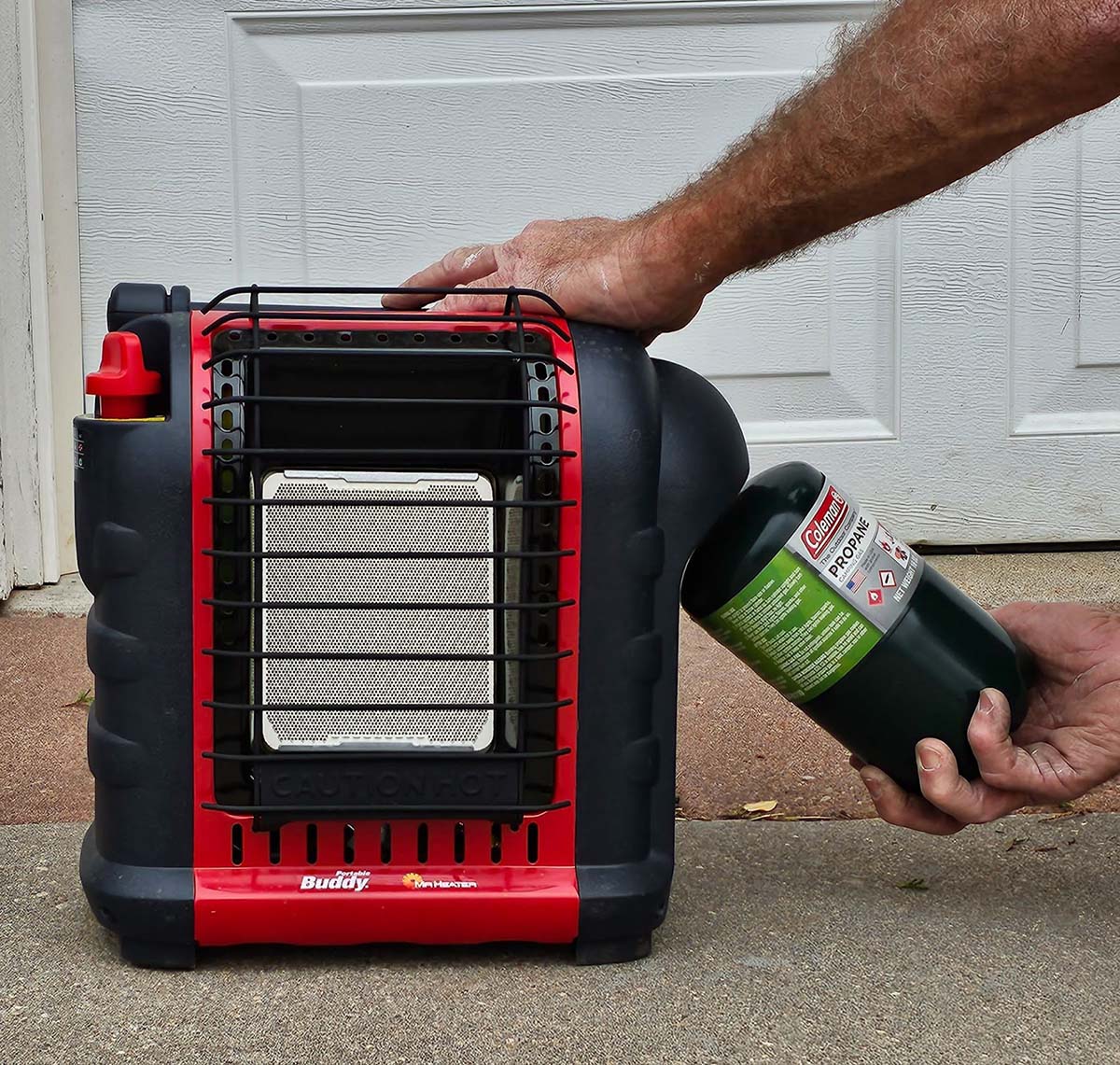
Weight and Portability
Decide what is needed from an electric heater. For example, do you require a heater for a dedicated space or a unit that can move from place to place? Knowing how a heater might be used can help determine whether to look for a portable or stationary unit.
Portable heaters weigh as little as 5 pounds up to 20 pounds and are available as radiant, convection, or forced-air varieties. Many portable heaters feature impact-resistant construction and large handles for easy transport. Some even come with carrying cases.
Larger non-electric heaters, such as the powerful tower heaters used on backyard patios and in outdoor eating areas at restaurants, weigh upward of 70 pounds, not including the 20-pound tanks that power them. While these are not portable, most have wheels to allow for repositioning. Other permanent heaters include kits that enable mounting on a wall or to the floor.
Tank Size
Tank size determines just how long a heater will work before it’s time to replace the fuel. Kerosene heaters have tanks that hold liquid kerosene. A kerosene heater with a 1-gallon tank will provide about 14 hours of use before it needs more fuel.
Propane works differently. Because propane gas is a compressed liquid, it comes in tanks that attach to the heater via a valve and a hose. Larger heaters use a 20-pound tank, which provides about 10 hours of use. Portable propane heaters use 16-ounce canisters, which last about 3 hours.
Whereas most kerosene tanks include fuel gauges, most propane tanks do not, making it difficult to know just how much remains in the tank.
Power
It’s best to take the Goldilocks approach when selecting a gas heater since a heater with insufficient power will leave a room too cold, while a heater that is too powerful will make it too hot. The best non-electric heater needs to be just right.
Energy is measured in BTUs. More BTUs mean more heat output. Most manufacturers also rate their indoor heaters by square footage. For example, an indoor heater with a maximum BTU of 9,000 can heat up to 225 square feet. While 7,000 BTUs might be adequate to warm a 300-square-foot room, an outdoor heater may need more than 40,000 BTUs to keep an open-air space warm. Indoor and portable heaters typically have an output of around 5,000 BTUs.
Although it’s tempting to get the most powerful heater you can afford, you might regret it. A heater with a high minimum BTU output will quickly overheat a smaller space, making it challenging to regulate the room temperature. Unless a sauna is the goal, make sure to pay attention to square-footage ratings when deciding which heater will provide that just-right temperature.
Types of Non-Electric Heaters
Non-electric heaters fall into three categories: propane, kerosene, and natural gas. Some heaters are dual fuel, which means they can run off either propane or natural gas. While all these types can do the job when it comes to providing heat, they each operate differently. Understanding which works best for your specific needs is key to making the right decision when purchasing a non-electric space heater.
All non-electric heaters produce radiant or convection heat. Radiant heaters generate infrared heat using metal tubes that radiate heat, which warms objects in the room. With radiant heat, the closer you are to the heater, the warmer you get.
A convection heater pulls in the air around it, warms it, and then distributes the warmed air with a blower. While radiant heaters will quickly warm people close to the heater, convection heaters do a better job of distributing heat around a room.
If you’re a football fan, then you‘ve likely seen propane and kerosene forced-air heaters warming the sidelines of games played in subfreezing temperatures. Forced-air heaters have a distinctive cannon shape and function by blowing heat in one direction. They are mighty but noisy, which makes them attractive for industrial settings such as barns, warehouses, and construction sites, but they’re impractical for home use.
Propane
Propane heaters come in various forms, ranging from tower-shaped outdoor heaters to smaller portable models. Propane heaters use refillable tanks and canisters ranging in size from a 16-ounce canister to a 20-pound tank.
Propane heaters that use small canisters are lightweight. When used properly, they can be safe for indoor or outdoor use and are easy to move from room to room. Some are even small enough to take on a camping trip. Small propane heaters are capable of producing up to 18,000 BTUs of heat output. Larger outdoor-only models are tower shaped, making them ideal for patios and decks. These large heaters can pump out up to 40,000 BTUs of heat.
Propane heaters have a low oxygen shutoff and a tip-over shutoff as standard safety features.
Kerosene
Kerosene burns efficiently and heats very quickly, making kerosene heaters an ideal option for supplemental home heating. Like propane, kerosene heaters fall into two categories: radiant and convection. Convective kerosene heaters have a tower shape with a broad base that contains the fuel and a cylinder that comprises the heater’s combustion chamber. Their circular shape allows them to warm air in all directions. Radiant heaters are rectangular and have a reflector or electric blower that directs the heat it produces in one direction.
Kerosene heaters use liquid kerosene, which is available at most home improvement stores. Unlike propane, which uses a spark for ignition, kerosene requires a wick, which soaks up and burns the fuel. Wicks typically last for about a year.
Natural Gas
More than half the homes in the United States use natural gas as their primary heat source, according to the U.S. Energy Information Administration. If you’re in that half, then a natural gas non-electric heater might be for you.
Natural gas heaters function similarly to propane heaters, but instead of needing a tank, they tie directly into the home’s gas line. If the gas line is not already installed, this may require professional installation. A natural gas setup eliminates trips to refill a propane tank, but it sacrifices portability; if you opt to use natural gas, the heater must be installed close to a fixed gas connection. With this in mind, most natural gas heaters are larger, more permanent appliances.
Do keep in mind that you cannot hook up a propane heater to a natural gas line. Only install heaters designed for use with natural gas to a natural gas line.
The Advantages of Owning a Non-Electric Heater
No matter what type of fuel you choose and whether you decide on a portable permanent indoor or outdoor model, a non-electric heater is a useful appliance to have in most households. Non-electric heaters can supplement a home’s HVAC system, providing heat for those underserved cold spots. They can also extend the usability of an outdoor living space, allowing you to enjoy that deck or patio year-round.
Most importantly, non-electric heaters function as a valuable emergency heat source, keeping a family warm while they wait for the power to return after a home’s HVAC system is put out of commission by a power outage.
The benefits of owning a non-electric heater include the following:
- Supplements an existing HVAC system
- Provides an alternate heat source during a power outage
- Makes unheated living spaces usable in cold weather
Safety Tips for Using Non-Electric Heaters
Because non-electric heaters involve fuel and flames, it’s essential to follow certain safety guidelines and consider only models with standard safety features. A non-electric heater should have tipping and low-oxygen sensors that shut off the heater when triggered. Safe heaters will have a shield that prevents contact with an open flame, such as a glass window or a metal grate.
Even with these safety features, it’s also essential to follow some common-sense practices when using a non-electric heater. Make sure to place the heater in a low-traffic area to prevent people and pets from bumping the unit. Set up non-electric heaters on even ground to avoid fuel spills or flame exposure. Also, allow for a buffer of at least 3 feet between the heater and flammable materials.
The safety tips for non-electric heaters include the following:
- Only purchase a heater with built-in safety features.
- Allow for a buffer of at least 3 feet between flammable materials and the heater.
- Make sure the heater sits on even ground.
- Keep the heater out of high-traffic areas.
FAQs
Now that you’ve learned about what to look for while shopping for a non-electric heater, there may still be some lingering questions about specifics. Read on for answers to some of the most frequently asked questions.
Q. How can I heat my house without electricity?
The best way to heat a home during a power outage is to have a gas alternative. This can consist of a ventless gas fireplace that runs off of natural gas or propane, or a gas-powered heater. Since these units require no electrical connection to operate, they are an ideal backup during a winter storm power outage.
Q. Is there a battery-operated heater option to heat my home?
Since electric heaters use a minimum of 900 watts and as much as 1,500 watts, even a large 12-volt battery doesn’t have enough juice to power a heater, making a gas heater the best alternative to electric heat.
Q. What is the safest non-electric heater?
While there isn’t a single heater that is the safest non-electric heater, those with certain safety features are safer than those without. Look for gas heaters that have auto shut-off features that automatically turn off the unit if it tips over or begins to overheat or senses low oxygen levels in the surrounding air.
Meet the Testers
Stacey L. Nash has written about home and garden products, home design and decor, and general indoor and outdoor home improvement for 5-plus years. She’s passionate about research and hands-on testing to find the products that add true value to homeownership and daily life. She lives on 12 heavily wooded acres, where she and her family put home and outdoor products to the test while avoiding bears and cougars.
Tom Scalisi is a full-time DIY and construction writer for many of the largest websites in the industry, including BobVila.com, This Old House, Family Handyman, and Forbes as well as his own pest control blog.
Additional research provided by Tony Carrick.
